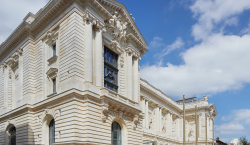Musée d’Art de Nantes Wins Two Awards in Two Weeks!
9 May 2018
The refurbished and extended Musée d’Art de Nantes has won two awards in the space of two weeks!
Last week, Max Fordham's Light + Air group won the award for Daylight Project of the Year at the Lighting Design Awards.
And this week, Musée d’Art de Nantes was awarded a RIBA Award for International Excellence, which means it is also now in the running for the RIBA International Prize. More information can be found on RIBA's awards website.
About Musée d’Art de Nantes:
The major renovation and extension of the 19th century Palais des Beaux-Arts created more than 17,000m2 of floor space - including a new building dedicated to contemporary art - to display the Museum's impressive collection and host prestigious exhibitions.
Working with Stanton Williams Architects, Max Fordham provided M&E engineering services, as well as sustainability consultancy to achieve an internal environment that is suitable for visitors and art conservation, with minimal energy use. We also designed both gallery and architectural lighting schemes across the site, and acoustic design to manage sound without impacting the design intent of the architect.
One of the principal aims of the renovation was to improve the gallery environment, both for visitors and the conservation of art. We did this by adding air conditioning, controlling daylight levels, and reducing noise levels. We met and exceeded the brief for the energy and environmental performance of the project, assessed against the French HQE system which is analogous to BREEAM in the UK.
About the lighting design:
The different lit character of the spaces helps define the journey through the museum. Spaces displaying older parts of the collection, for example oil paintings, are treated with warm light focused onto the canvases to help lift the colours, whereas contemporary works are positioned in bright ambient spaces which have a more subtle style of emphasis.
The old lighting used in the Palais galleries has been replaced with complex layers of superimposed glass, stretched fabric and controllable blinds, resulting in a ‘passing cloud’ effect. The quantity of natural light is controlled but with a soft touch: on especially bright days, blinds start to close to preserve the artworks, but levels are usually allowed to vary in order to embrace the changeability of sun and skylight both in tone and intensity. Glass of varying transmission is used above the galleries and for different orientations, to make the light more consistent and avoid overheating. Between galleries and external glazing, perforate blinds and diffusing membranes help manage brightness and even-out the light.
Most of the main lighting pieces were bespoke designed for Nantes.





.jpg)